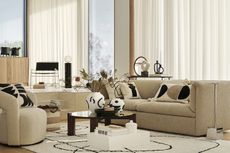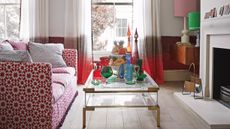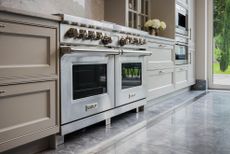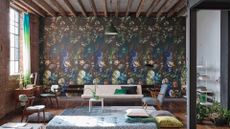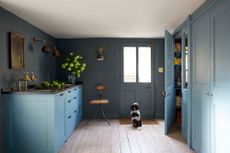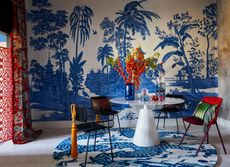How To Plan & Design A Home Swimming Pool: 7 Important Things To Consider
We spoke to architect Pawel Nawojczyk to discuss all things swimming pool; from energy efficiency and essential things to consider, to funky extras including moving floors, underwater speakers and swim-up home bars. Here he lays down the 7 key things to consider before you start your home swimming pool design.

Longing to design or install a home swimming pool? Read these insightful points from a swimming pool design expert first. Pawel Nawojczyk, Associate Director at SHH explains seven key things to consider before you start any swimming pool project.
A swimming pool at home has many benefits and can serve an abundance of purposes. From basic relaxation and leisure, through health (exercise, hydrotherapy) right to being part of the aesthetic landscape, or simply a statement of wealth and status. But a pool is also a commitment; a quality pool is a substantial investment that when not planned well and not looked after properly, can soon become unappealing, underused or even dangerous.
As much as the end target is simple (enjoyment), the design process is anything but, and it's crucial to think about every aspect from the outset, to avoid expensive mistakes.

1. WHY: BEFORE YOU COMMIT
SHH's Associate Director Pawel Nawojczyk advises that the first thing to ask yourself is: is it essential? 'A swimming pool is a big commitment: construction costs, maintenance, treatment, energy, water use and so on,' he says. It's important to asses how much the swimming pool will actually be used, by whom, and for what, and to think about what the alternatives are. 'One of our high-end clients in the past said “if I want a swim I will go to my local club” and instead opted for a playroom, gym, wine store and other functions in the new basement. A wise decision at the time. Then, as soon as kids started complaining during a hot summer two years later, we were back assessing the possibility of introducing a pool into his garden.'
2. WHERE: INDOOR, OUTDOOR OR HYBRID?
When it comes to deciding on having an indoor, outdoor or hybrid pool, there are a lot of factors at play. For example, the function and use may have certain requirements (such as size) that will dictate where the pool can be located.
Pragmatic but critical matters include the implications on adjoining structures, underground services, geotechnical characteristics and hydrology of the setting (a swimming pool will weigh a lot!). You'll also want to make sure the pool is in the best place for adequate drainage and services. Once you've got an idea of what's actually possible, then you can start to think about the design and look.
OUTDOOR POOLS
For an outdoor swimming pool, you'll want to look forthe largest area with least obstructions, ensuring the most use of the sun, and ideally away from trees (less debris falling into the pool, root protection zones, avoiding overshadowing, etc). This will determine the available space and resulting pool size.

'Pools on a sloping plot make for a stunning feature, especially when approached as an infinity pool, connecting the water with fantastic views. Climate also will have an effect on location; a pool we completed for a residence in Dubai was located closer to the building, allowing for shielding from the sun. Due to the hot weather and life focused on the indoors, the pool appearance and composition here was of utmost importance becoming a feature outlook rather than an intensely used pool. You also will have to consider planning restrictions (though a domestic garden pool at the back might normally not require consent, it is worth checking with the local planning authority as tree preservation orders, property listed status, conservation area constraints and other factors might restrict what is possible)', explains architect Pawel Nawojczyk.
INDOOR POOLS
Indoor pools will provide year-round use with a controlled environment – ideal for cooler climates. These pools require more design thought – for example, finishes will affect the feel of the space but also aspects such as acoustics and maintenance. There's also a different approach needed for above ground pools with plenty of natural light and ventilation, compared to underground enclosures where light and fit out will determine how one will feel in the space.

HYBRID POOLS
A hybrid pool is where the pool is partly indoors, part outdoors. These have proven to be a success, linking the benefits of the two options. The pool is divided with an insulated boom sliding up from a trough in the floor, which then meets a window sliding down from above. Depending on the approach and arrangement, the window and boom can be opened creating one long pool, whilst during colder months, just the boom could be lowered where the window continues to provide air separation between the inside and outside. The inside and outside then have separate water treatment plant, to ensure that in winter the outside can be run at a temperature sufficient to get through winter, whilst the indoors is heated to the indoor temperature for everyday use, ensuring energy is not wasted (these are additionally protected with covers to lower energy loss).

3. WHO: PURPOSE AND USERS
'Once we know where the pool will be located, it is time to think how and by whom it will be used', Pawel explains. 'The purpose will have an impact on the shape, size, depth as well as other functional extras – for example whether access should be via ladders or steps.'
People choose to have swimming pools for a variety of different reasons and intentions, and these all affect the approach to the swimming pool design.
STATUS
A status or designer pool will be more refined, with practicality not necessarily the prime aspect (though still an important factor). A well designed and well-executed pool elevates the prestige and wealth perception of a property.

A striking outdoor pool will most likely require careful blending with the landscape composition, becoming an integral part of the surroundings and a real feature. Here materials will be rich and working in harmony with the water reflections, lighting, surrounding finishes and perhaps even finishes that continue from the house connecting the inside with the outside for formal evening entertaining backdrop.
An indoor pool, still using rich and sophisticated designs, will normally form part of a spa complex with additional functions emphasising the luxurious lifestyle it addresses - a steam room, sauna, spa, plunge pools, massage and beauty salons, home gym etc. This will most often be a level deck pool, where the water level is flush with the flooring around.

RELAXATION
A pool that is focused on relaxation and contemplation will be approached as a retreat with moodier finishes, warmer water and cave-like/zen feel with moody lighting and darker palette, promoting mindfulness and time with oneself.


Music, lighting and even fragrance become very important and having this in a basement might augment the sensations being completely separated from the surroundings.
FAMILY FUN
A family fun pool can be more creative with a shape that can divide the pool into zones and add interest, for example denoting different water depths or functions such as jets and integrated seating, a diving area or secluded retreat. Practical things need to be considered more carefully, such as slip resistance, and parents will want to consider mitigating sharp edges and corners, picking splash resistant and durable finishes, and consider acoustic treatment to walls to mitigate noise build up, as well as access via friendly steps to shallow water rather than ladders straight into the deep.

Practicality and safety is key here. Due to vulnerable users (wide user age range), a family pool also needs enhanced safety in relation to access and monitoring. Depth of the pool should be adjusted to the intended use; avoiding sudden and steep slopes. A home pool can also integrate water rehabilitation (aquatic therapy) or basic exercising, and it is a good approach to provide for many generations in line with the Lifetime Home recommendations, ensuring longevity of the build. Added functionality such as level floors and large spaces for exercising, added safety such as grab rails that can also be decorative, lifts as may be required.

EXERCISE
If the home swimming pool is purely for sport, this needs a regular shape with clear swimming lanes, an adequate length for doing laps. It would be less decorative, focusing on performance (visual, spatial and functional); for example, the end of the pool should be clearly visible whilst swimming, shell robust enough for turns, lanes clear of any protrusions such as steps into the pool.

Where length is not available, options such as a current generator are available. These solutions can be introduced into bespoke pools, but there are also proprietary prefabricated small swimming pools that provide current for swimming and are integrated with spa function and may even have an underwater treadmill for exercising.

4. FINISHES
Finishes are directly linked to the function. Some pools will benefit from lighter touches, others will be better off with a darker colour palette. Textured walls and intricate ceiling will help with the acoustic environment. Lighting and feature walls such as planting (to be selected to work with the pool environment or use high quality artificial options which help with acoustics as well) will bring in calm and a sense of homeliness to the decor. A feature pool will focus on quality and visual impact, whilst dynamic use will require the durability and practicality of the materials, including slip resistance or being able to withstand staining or chemical deterioration. A dark pool will certainly be a statement, but lighting is key. This will also warm up more with solar gains and so it will be good for an outdoor pool here, whilst in a hot climate this might not necessarily be the best option.
The finishes also need to work with the available light; will the swimming pool be naturally lit (e.g. on the ground floor or lower ground floor with a light-well, or skylights when in a basement), or will this be a fully artificial scheme.

Finishes can range from applied in situ monolithic mineral coatings (e.g. aggregate pool finishes), through vinyl linings, to the usual tiling approach, whether in tiles or mosaics. There are also stainless-steel pools that seem to be growing in popularity as well as glazed walls. All materials, especially natural such as stone, must be confirmed with the manufacturer that the proposed use is appropriate for the selected finish.

All finishes and materials should withstand the aggressive nature of a pool environment. Even those with minimal amount of chlorine are aggressive and will lead to corrosion of wrongly selected materials.
5. PRACTICAL CONSIDERATIONS
Swimming pool design brings with it a long list of practical considerations. You'll want to think about everything from safety, access, fire escape, pool covers, and depth to the energy efficiency, heating, and chlorine levels.
In terms of safety, you'll need to think about who will have access and how will this be restricted. A swimming pool does pose a risk of drowning and there are countries where fences around pools are obligatory. If circumstances permit, you could have these designed in – for example landscaped hedging with a secured gate for outdoor swimming pools, or coded doors for indoor pools. There are also sensors that can be installed, raising an alarm when the water surface is disturbed.

In terms of chlorine levels, no one likes the smell and aggressive feel of chlorine in public pools. There are other options, including low chlorine, UV light, salt etc. Each has its pros and cons; one will work better outside with the natural light enhancing the chemical reactions, others are fine inside the house, some will need more maintenance than others but be more effective.
You'll also want to design the pool with a lobby / separation to the house to mitigate smells from the pool area venturing to the rest of the house.
When it comes to energy efficiency, swimming pools should be designed to use as little energy as possible. Pool covers can protect the water from heat loss when it's not in use. You'll also want to install energy efficient light fittings with appropriate IP rating. But not all design can lend itself to energy efficiency; 'a swimming pool project in Dubai was fitted with a cooling facility (and enhanced filtering system due to the sand storms), dictated by the local climate', Pawel explains.
6. WOW-FACTOR
When it comes to wow-factor, it's all about the little extras. 'We installed a pool where the kids’ level on the first floor had a slide going directly down to the pool on the ground floor. A fun and unusual installation that was well loved by the family', says Pawel. Other extras could include diving boards, trampolines, fountains and massaging waterfalls, water current generators, and integrated sitting with air jets.
Speakers are paramount – but there are even options out there for underwater speakers too.
Moving floors could change the depth of the pool, making it shallower for children, and deeper for exercise. A moving floor can then even be raised to floor level, to become a dance floor for example.

For a hotel-vibe, you could even design a swim-up home bar, so guests can sit on bar stools submerged in water and chat to the person behind the bar.
There also purely aesthetic features to choose from, such as see-through walls or floors; 'We had designed a pool in North London with glazed panels from a media room located a floor below' says Pawel.
7. INTEGRATED FUNCTIONS
Pools very often are not a standalone item. Aside from essential ancillary functions, such as plant rooms, changing rooms, and storage, swimming pools often come as part of a wellbeing complex.
A pool can have an integrated or adjoining spa. This can be completely separate or be joined with a shallow body of water across the division giving an illusion of continuity.
A home spa could also include a steam room and sauna, an ice shower and plunge pool, and an integrated home bar sunken next to to the pool to ensure the serving is at the right height when in the pool. A pool house for external pools can also provide a lounging area and serving facilities rather than be purely functional.

FOOD FOR THOUGHT
A final note from Pawel; 'a home swimming pool is a very broad topic with a wide variety of considerations to be aware of. The best advice I could give is to take your time to think this through carefully and engage the right design team from the outset for the best end results that will fulfil the potential of the endeavour to the maximum'.
Be The First To Know
The Livingetc newsletter is your shortcut to the now and the next in home design. Subscribe today to receive a stunning free 200-page book of the best homes from around the world.
Lotte is the Digital Editor for Livingetc, and has been with the website since its launch. She has a background in online journalism and writing for SEO, with previous editor roles at Good Living, Good Housekeeping, Country & Townhouse, and BBC Good Food among others, as well as her own successful interiors blog. When she's not busy writing or tracking analytics, she's doing up houses, two of which have features in interior design magazines. She's just finished doing up her house in Wimbledon, and is eyeing up Bath for her next project.
-
 How to Thaw a Frozen Pipe — Learn Everything You Need to Know in 5 Minutes With This Guide
How to Thaw a Frozen Pipe — Learn Everything You Need to Know in 5 Minutes With This GuideWinter storm caught you off guard? We asked an expert — just how do you thaw a frozen pipe?
By Hugh Metcalf Published
-
 The 12 Very Best Silk Bedding Pieces — As Our Style Editor Says: 'It's What Dreams Are Made Of!'
The 12 Very Best Silk Bedding Pieces — As Our Style Editor Says: 'It's What Dreams Are Made Of!'Slumber in lustrous luxury with the very best silk bedding sheets, duvets, pillowcases, and more — your sleep score will thank us later
By Julia Demer Published
-
 Florist Angela Maynard on how to care for dried flowers and how to style them in a modern home
Florist Angela Maynard on how to care for dried flowers and how to style them in a modern homeKnowing how to care for dried flowers means you can have stylish arrangements that last for years. Author and florist Angela Maynard shares her tips
By Angela Maynard Last updated
-
 11 beige living room ideas that prove beige can be far from boring
11 beige living room ideas that prove beige can be far from boringBeige living room ideas might sound not sound like the boldest of color schemes but this pared-back palette can be just as striking a brights
By Amy Moorea Wong Last updated
-
 How to use color in small living rooms – expert tips for getting the perfect scheme
How to use color in small living rooms – expert tips for getting the perfect schemeBringing color into small living rooms can be tricky, but with the right hues and our top tips, you can make the space look brighter, bigger and just better
By katesleeman Published
-
 How to choose cool colour combinations for your home
How to choose cool colour combinations for your homeThe right colour combinations will look good throughout your home. Dagny Thurmann-Moe of Koi Colour Studio shares the no-go palette pairings and power hues
By Livingetc Published
-
 Buying a used kitchen could be your savviest design idea - here's what you need to know
Buying a used kitchen could be your savviest design idea - here's what you need to knowBuying an ex-display used kitchen is a way to a high-end home at High Street prices
By Jacky Parker Published
-
 Home decorating: Tricia Guild's guide to a confident scheme
Home decorating: Tricia Guild's guide to a confident schemeHome decorating advice from legendary designer Tricia Guild OBE
By Livingetc Published
-
 How to achieve beautiful paint finishes according to interior designer, Nicola Harding
How to achieve beautiful paint finishes according to interior designer, Nicola HardingBeautiful paint finishes transform a room and are easier than you think
By Livingetc Last updated
-
 The meaning of style, by interior designer Russell Sage
The meaning of style, by interior designer Russell SageAcclaimed interior designer Russell Sage talks broken rules, secret ingredients and looking good in any light
By Russell Sage Published



